Welder Falls from Boom Forklift Platform When Boom Shifts Laterally
Iowa Case Report: 03IA021
Report Date: August 25, 2004
Summary
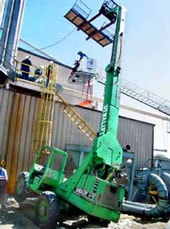 |
|
Photo 1 – Police photo of the scene showing the new catwalk, and the boom forklift, leaning to the right.
|
A 39-year-old welder was killed when he fell 20 feet off a platform attached to the forks of a boom forklift. The man was part of a 3-man crew installing a catwalk and ladder assembly along the side of a cement silo for a wood products company. The work platform was specifically made by the company for use with their rough terrain forklift. It was 4 x 12 ft. and had removable guardrails on its perimeter, except for the end where the victim was working. The platform was at a working height of 35-40 ft. off the ground while a co-worker was on a catwalk 20 ft. below the victim. The owner of the company was operating the forklift truck on the ground.
At one point, the men were adjusting the lateral position of the raised platform using the frametilt function (sway control) of the forklift. While moving the platform to the right, the victim yelled, “Stop”, however the boom and the platform kept moving to the far right position and the victim fell off the unprotected left end of the platform, landing on the metal catwalk 20 ft. below him. The man was not wearing any sort of harness or safety line, nor was he wearing a hard hat. He sustained fatal head injuries and was dead at the scene when firefighters arrived. At that time the boom for the forklift was situated to the far right position with the left front wheel of the machine raised two feet off the ground (see Photo 1).
Recommendations based on our investigation are as follows:
- Operators of rough terrain forklifts should never use the sway control feature of the machine to make lateral adjustments of a raised load.
- Company-built personnel platforms on extended boom forklifts must comply with ANSI / ASME standards and OSHA regulations.
- Those who use a personnel platform on a rough terrain boom forklift must still use approved fall-protective equipment.
Introduction
During the spring of 2003, a 39-year-old welder died after falling from an aerial work platform attached to a forklift truck. The Iowa FACE program was notified of this incident the next day from the State Medical Examiner, and began an investigation. Additional information was gathered from newspapers, the forklift manufacturer, OSHA, and the county Sheriff, who also provided excellent photographs of the scene.
The employer was a metal fabricator from the local community. Two employees and the owner of the company were working at that location, the victim working on the personnel platform as a welder. Other details about this victim, and his company’s safety program or written policies are unknown, as the company owner was unwilling to discuss this incident further with investigators.
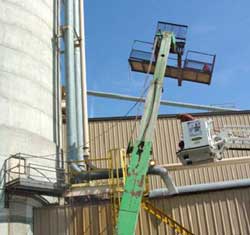 |
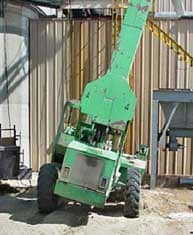 |
| Photo 2 – Shot from the rear of the machine, showing the platform tilted far to the right. | Photo 3 – View from the rear of the machine, tilted to the extreme right. |
Investigation
The 3-man work crew was building a new catwalk and ladder assembly on the side of a cement silo, and the victim was working on a personnel platform as a welder. Also on the platform were a wire welder, a metal chop saw, some welding hand tools, and a welding mask. The work platform was made of steel with a plywood base, and was approximately 4 x 12 ft. in size. It was constructed with seven removable metal guardrail sections, two of which were missing from the corner adjacent to the silo where the victim was working (see Photo 4). Welded to the bottom of the platform were two 8-ft. long steel channels, which were made to receive the forks of the boom forklift truck (see Photo 5). It is not known how the extended channels were attached to the original forks of the machine. The boom forklift was routinely used in this manner for fabrication and assembly of various outdoor metal projects.
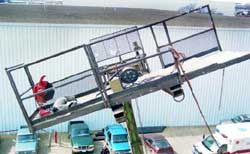 |
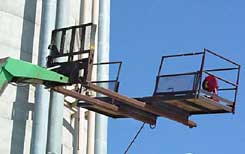 |
| Photo 4 – View from the firefighter’s ladder, showing details of the personnel platform, the tools onboard, the unprotected end, and the welded steel channels for the forks. | Photo 5 – Shot from underneath the platform showing the extended steel channels attached to the forks of the machine. |
A rough terrain boom forklift of this type is also called a telescopic handler by some manufacturers. It is designed to raise and extend loads in a single vertical plane, and does not provide for lateral movements of the boom, as is seen on larger truck-mounted cranes. These machines usually have built-in sway control, which is a method to level or tilt the frame of the machine if it is situated or traveling on ground that is sloping to the left or right. The axles of the machine are equipped with hydraulic cylinders, which the operator can actuate to shift the frame back to level before a lift is initiated. In the operator’s manual for this machine, the control for this is called the carriage tilt lever.
From photographs it is obvious the work platform is tilted far from the silo. The workers were accustomed to using the sway control feature of the machine to make minor lateral adjustments while personnel were on the platform. This was thought to be a very common procedure that many local construction crews did, and was not perceived as a dangerous action, although it is specifically forbidden in the operator’s manual for this forklift. The owner of this company was familiar with lighter-duty man lifts, but preferred this modified forklift for several reasons. Man lifts are designed to lift personnel with minimal tools and materials, but these machines were thought to be inherently lighter and less stable than the modified forklift, and they provided no means for lateral adjustments, nor did they provide space or lift capacity for tools like a welder, chop saw, angle irons, etc.
On the day of this incident, the crew was using the boom forklift in a fully raised and extended position, which placed the platform approximately 35-40 feet off the ground. They were adjusting the personnel platform slightly to the right (from the operator’s position) when the victim yelled to the operator to “Stop”. The boom kept moving to the extreme right position, however, and the victim apparently lost his balance and fell off the unprotected end of the platform. He was not wearing any sort of fall-protection safety gear, lifeline, or harness, and was not wearing a hart hat. The man fell to the existing metal catwalk about 20 feet below, where his co-worker was located. The welder received fatal head injuries and died at the scene. The operator of the forklift immediately called 911, but when rescue crews arrived, the victim was obviously dead at the scene and resuscitation was not attempted.
The left front wheel of the forklift raised two feet off the ground when the boom shifted to the far right position. It is unknown if the boom was stuck in this position, or why the boom was left in this position when firefighters arrived.
The operator’s manual from this manufacturer specifically warns against creating a custom work platform for personnel and attaching it to the forklift. However, over the last 10 years, this has become a common and accepted practice for many construction companies, and ASME gives detailed outlines in their standards (ASME B56.6-1992). The company in this case was cited by OSHA for failure to provide proper training to its employees regarding the specific hazards encountered at this worksite, and for failure to provide specific safety equipment necessary for employees, especially the victim working on the elevated platform. The owner did not get permission from the forklift manufacturer before constructing the work platform, nor before he attached the extended personnel platform to the forks of his machine.
Cause of Death
The cause of death as listed on the Medical Examiner’s report was, “multiple blunt force injuries of the head and neck“.
Recommendations/Discussion
Recommendation #1: Operators of rough terrain forklifts should never use the sway control feature of the machine to make lateral adjustments of a raised load.
Discussion: The approved use of the boom on this machine was strictly in an up and down motion, and there was no provision for lateral movements or rotation, which are possible on many larger truck-mounted cranes. One must back up and reposition the forklift if a lateral position is desired, even for a few inches. Normally, the frame-tilt (sway control) function of the forklift is used only for leveling the machine while traveling along sloping ground or making a lift on terrain that is slightly sloped to the right or left. The operator’s manual for this machine forbids traveling on slopes of greater than 16.5 degrees (left or right), and forbids placing or retrieving a load on slopes greater than 4.5 degrees (left or right). With the boom in a full vertical position, it is possible to make minor left and right shifts of the boom and the forks using the sway control feature. The owner’s manual for the forklift specifically warns against this practice, for obvious reasons of creating an off-balance load, losing the load, or tipping over of the machine. However, while using a relatively light-weight work platform, workers are tempted to make minor left and right adjustments with the hydraulic frame-tilt control. In this case, the platform was moved to the far right position when the sway control was used, causing the victim to lose his balance on the platform and fall off.
All forklift loads should be leveled before the lift is initiated, or before the boom is extended, and this especially applies to personnel platforms. It is never a good idea to use the sway control to make lateral adjustments while workers are on an extended and raised work platform. Small adjustments in the hydraulics of the sway control cylinders produce exaggerated movements of the forks if the boom is extended. If the sway control lever is rapidly pushed to one side, it will cause violent and jerky movements of the personnel platform if it is raised high off the ground.
Recommendation #2: Company-built personnel platforms on extended boom forklifts must comply with ANSI / ASME standards and OSHA regulations.
Discussion: ASME standards do allow a company to construct and attach a personnel platform to an extended-reach rough terrain boom forklift. There are rigorous guidelines for this, and it is therefore, preferred that individuals consult with the forklift manufacturer for assistance, or better, purchase a factory-made and approved personnel platform designed for their particular machine. Requirements for an approved personnel platform include proper size, approved guard rails, rated anchor points for attachment of lifelines, and a secure method to secure the platform to the forklift. OSHA frequently writes citations for inadequate / home-made personnel platforms, deferring to the restrictions written into machine operator’s manuals, which usually forbid using a personnel platform on the forklift. Manufacturers differ in their treatment of this issue, therefore companies desiring a personnel platform for a boom forklift should be diligent to study their options carefully.
In this case, the personnel platform was a few feet too wide. The ANSI standard for lift trucks (ANSI B56.6-2002 [8.24.1(b)])1 states the platform floor can’t exceed the overall width of a lift truck measured across the load-bearing tires plus 10 inches on either side. For this machine the maximum platform width would then be 96″ + 20″ = 116″ total inches. In addition, personnel platforms must be securely anchored to the forks of the machine. In this case it appears the platform was welded to extended steel channels, which were then attached to the forks. (see Photos 2, 4).
Recommendation #3: Those who use a personnel platform on a rough terrain boom forklift must still use approved fall-protective equipment.
Discussion: Approved equipment in this case would be use of a full body harness, and lifeline which does not permit a fall of more than six feet. This ruling applies to all extended boom machines, for they have the potential of bouncing a worker up and off the platform, even if the platform is equipped with permanently-mounted guard rails. Exceptions to this rule are for scissor lifts, which have permanently attached guard rails. These machines use hydraulic-powered mechanical linkages to slowly raise and lower the work platform, minimizing the potential to bounce a worker up and off of the platform. In this case, the victim was not wearing any type of fall protection, and was working near an unprotected edge of the personnel platform. When the sway control was activated, the hydraulic controls shifted the frame of the forklift to the right, and the extended work platform was also shifted further and faster to the right causing the victim to lose his balance and fall. Had the victim been wearing a body harness and lifeline properly anchored to the platform, it is likely he would have survived this fall.
In addition, the victim was not wearing a hard hat, which is very significant, since he died from severe head injuries. Several companies make combination welding mask / hard hats, which provide a dual function for specific construction jobs like this one.
Reference
- (American National Standards Institute, ANSI B56.6-2002 [8.24.1(b)])
Iowa FACE Program
FACE is an occupational fatality investigation and surveillance program of the National Institute for Occupational Safety and Health (NIOSH). In the state of Iowa, The University of Iowa, in conjunction with the Iowa Department of Public Health carries out the FACE program. The NIOSH head office in Morgantown, West Virginia, carries out an intramural FACE program and funds state based programs in Alaska, California, Iowa, Kentucky, Massachusetts, Michigan, Minnesota, Nebraska, New Jersey, New York, Oklahoma, Oregon, Washington, West Virginia, and Wisconsin.
The purpose of FACE is to identify all occupational fatalities in the participating states, conduct indepth investigations on specific types of fatalities, and make recommendations regarding prevention. NIOSH collects this information nationally and publishes reports and Alerts, which are disseminated widely to the involved industries. NIOSH FACE publications are available from the NIOSH Distribution Center (1-800-35NIOSH).
Iowa FACE publishes case reports, one page Warnings, and articles in trade journals. Most of this information is posted on our web site listed below. Copies of the reports and Warnings are available by contacting our offices in Iowa City, IA.
The Iowa FACE team consists of the following from the University of Iowa: Craig Zwerling, MD, PhD, MPH, Principal Investigator; Wayne Johnson, MD, Chief Investigator; John Lundell, MA, Coordinator; Risto Rautiainen, PhD, Co-Investigator, and John Kraemer, PA. from the Office of The State Medical Examiner.
To contact Iowa State FACE program personnel regarding State-based FACE reports, please use information listed on the Contact Sheet on the NIOSH FACE web site Please contact In-house FACE program personnel regarding In-house FACE reports and to gain assistance when State-FACE program personnel cannot be reached.

